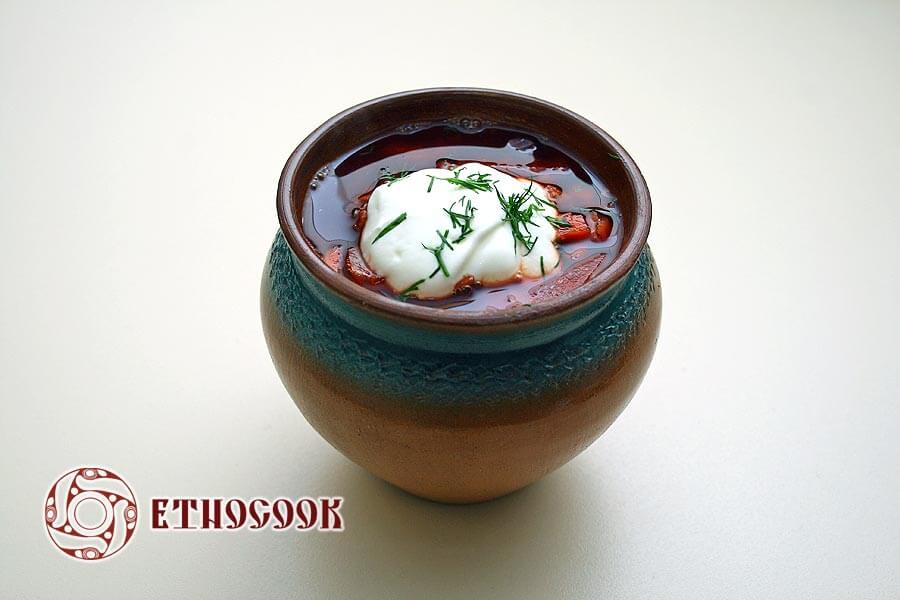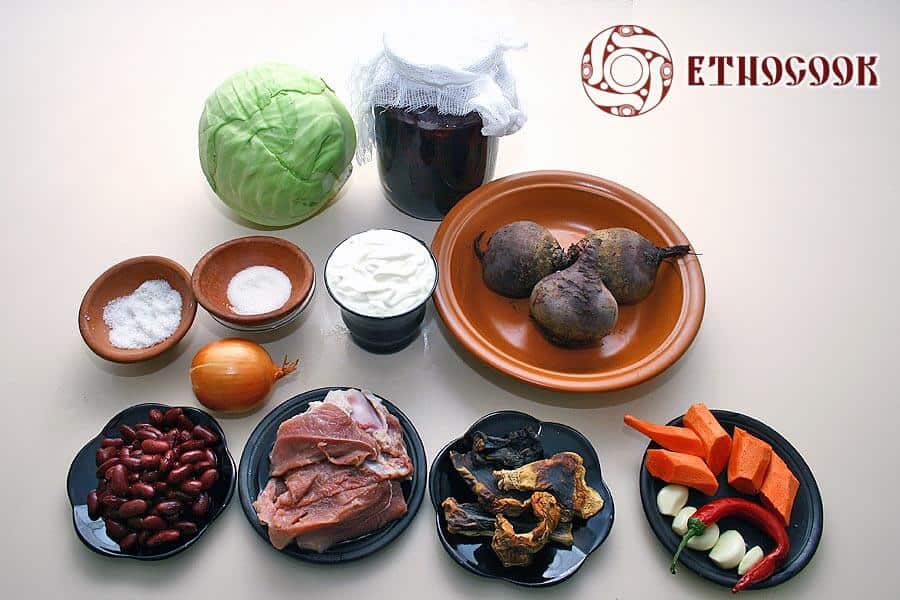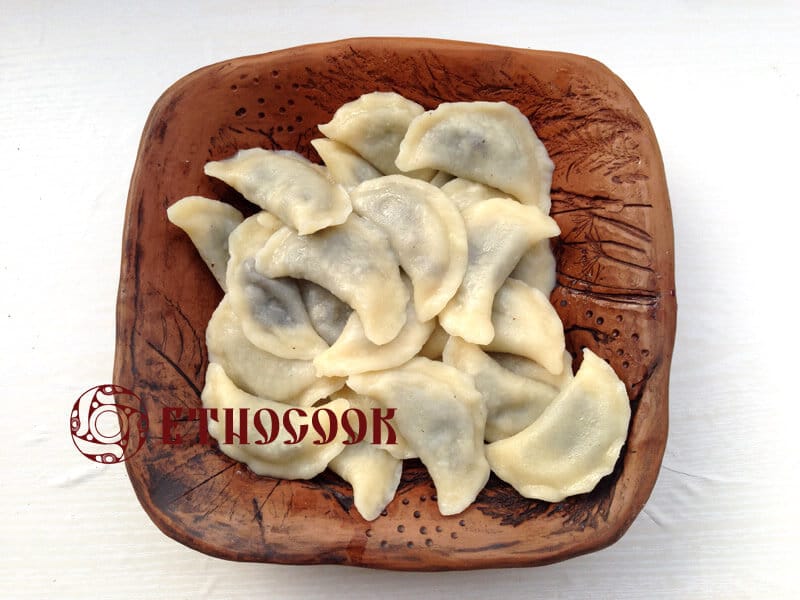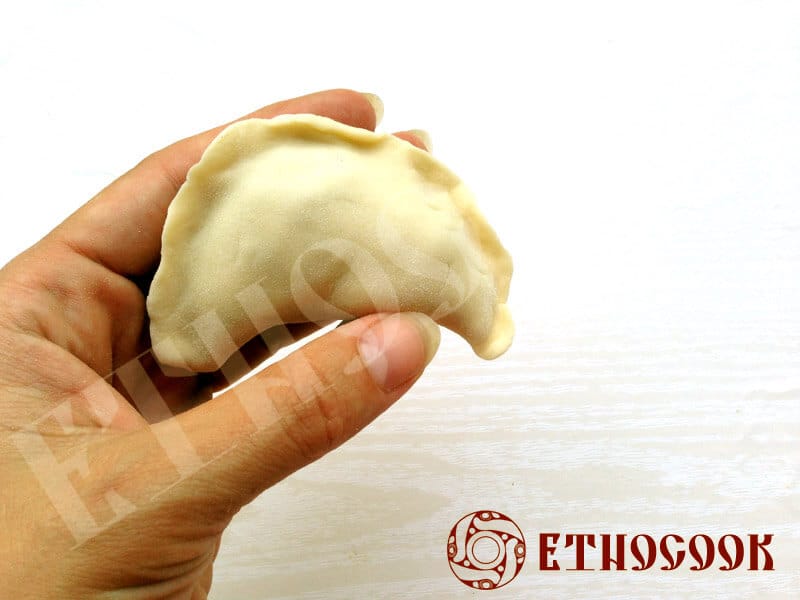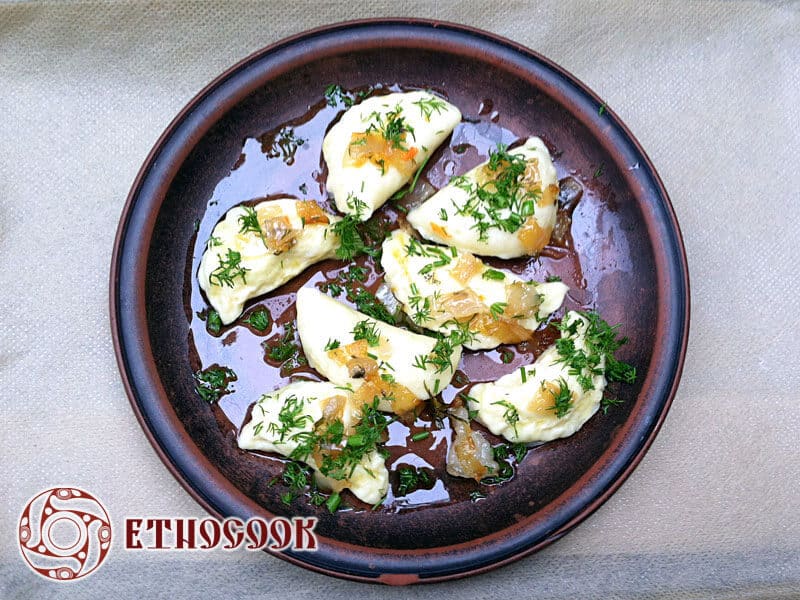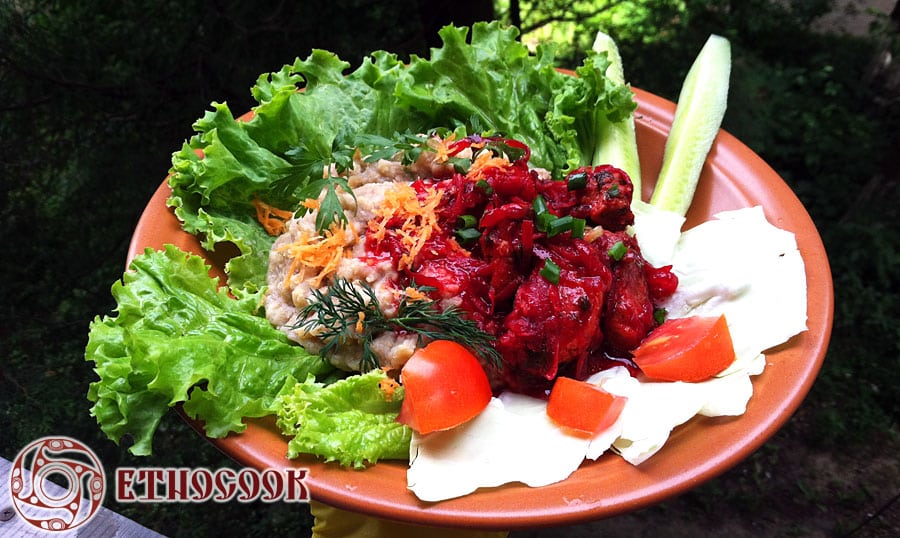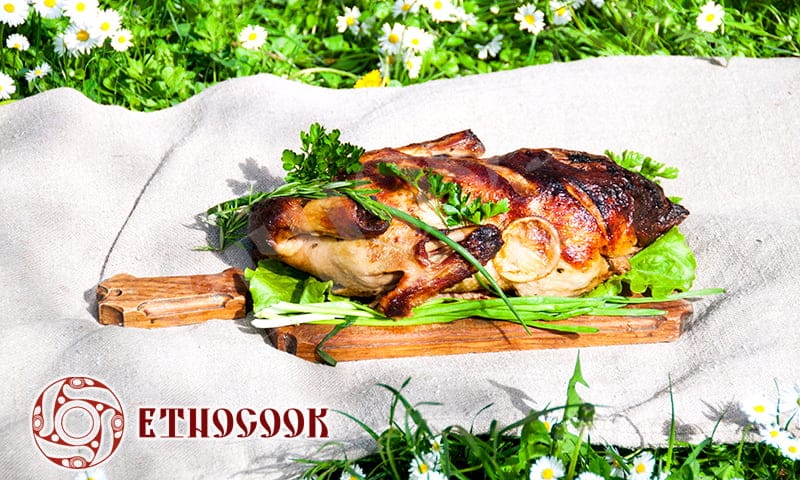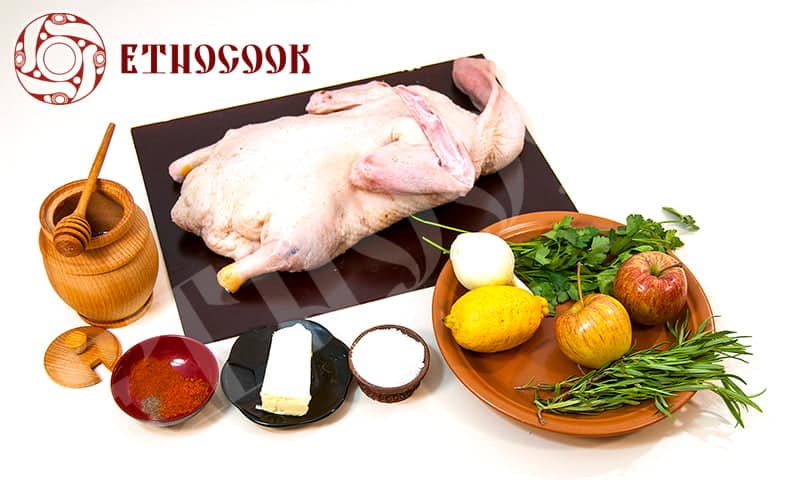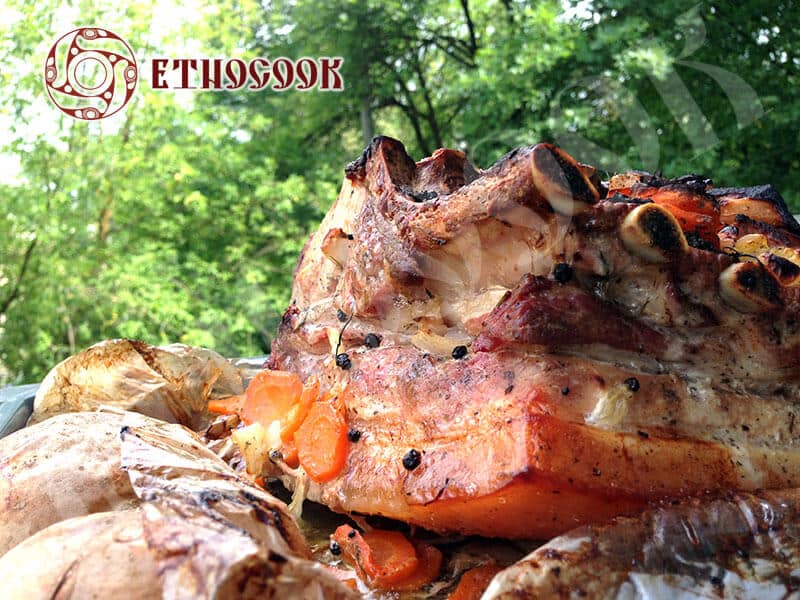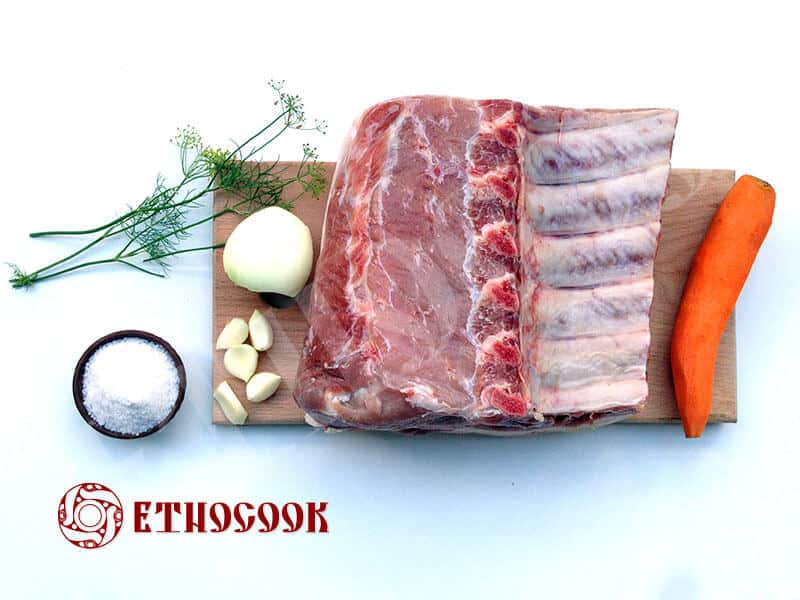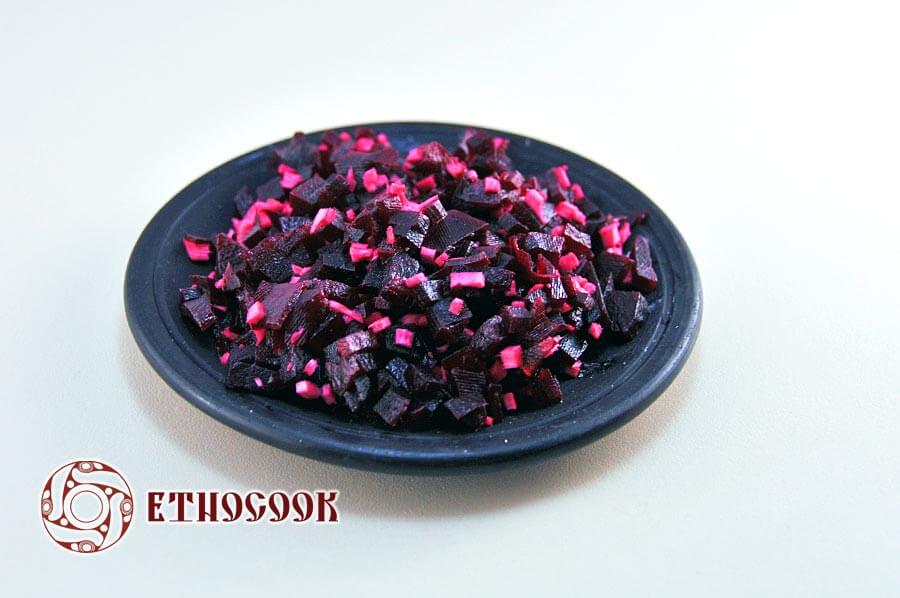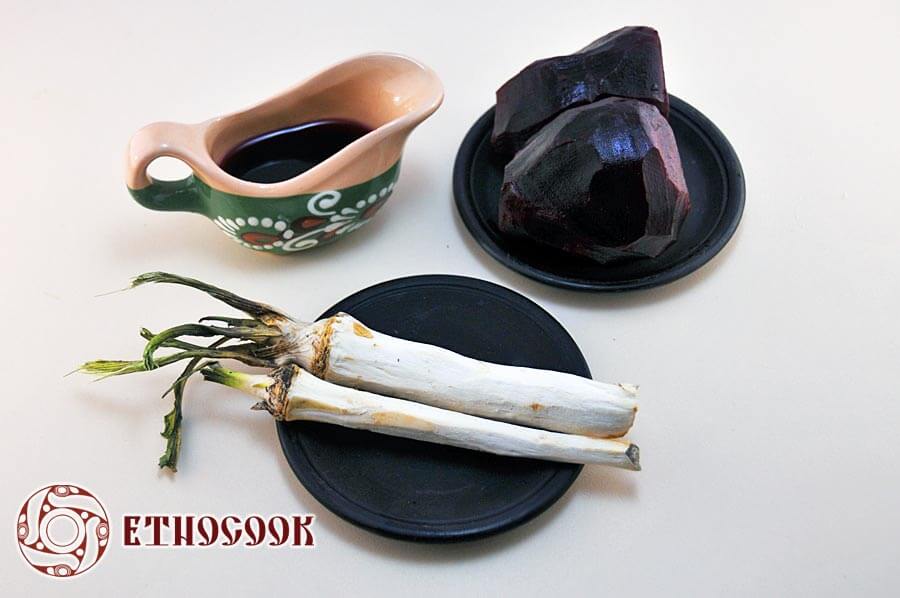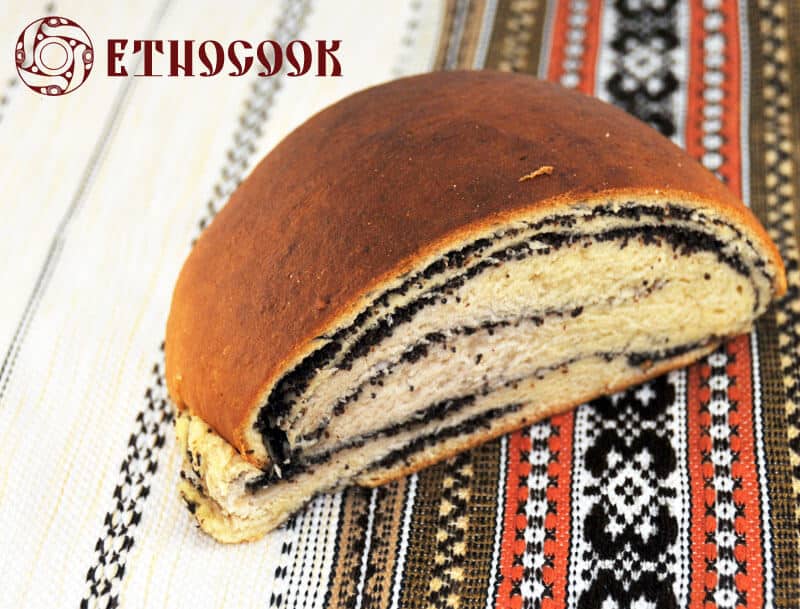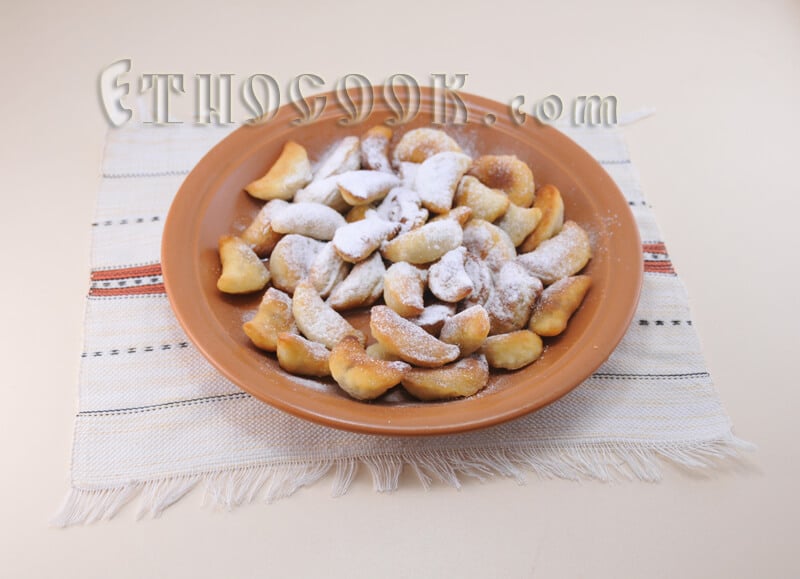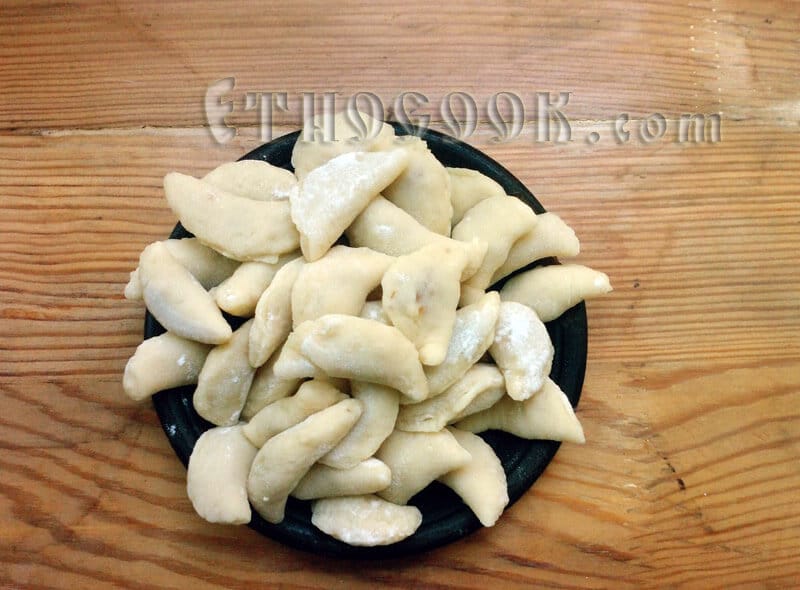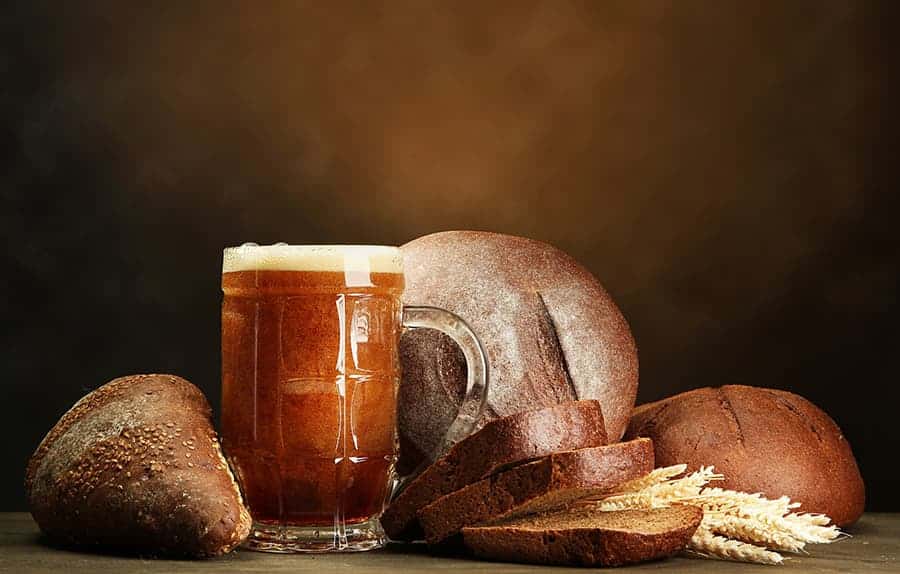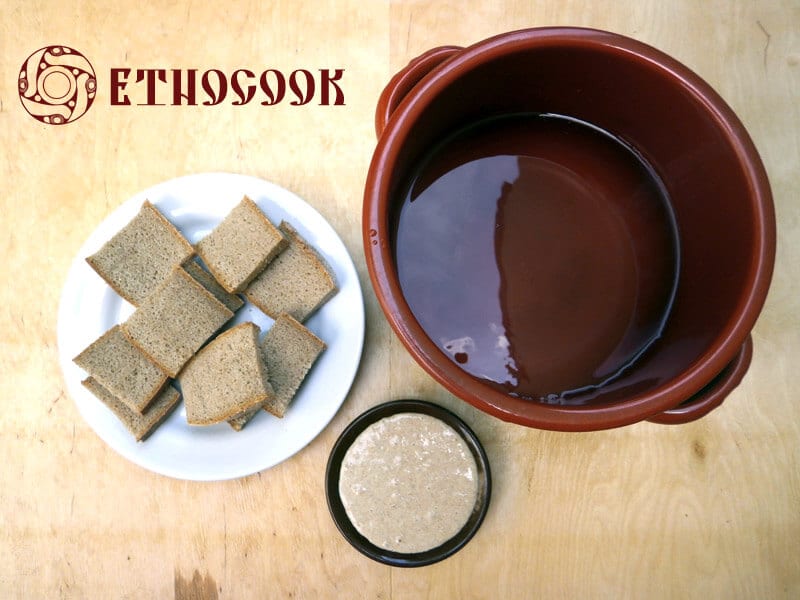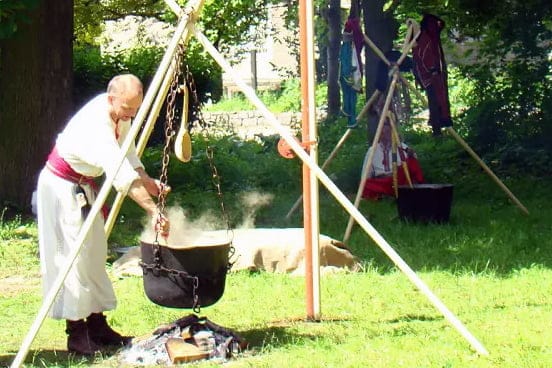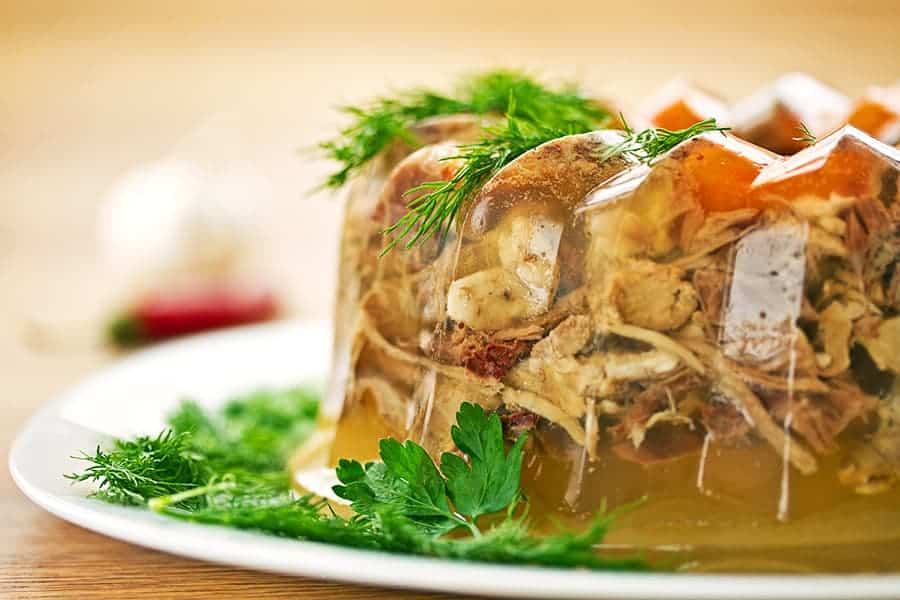- Borshch
- Nettle Soup
- Varenyky (Pyrohy) With Cheese
- Halushky
- Lopatky With Pork Rinds
- Shpundra
- Roast Duck With Apples And Honey
- Pork Loin Cooked In The Oven With Herbs
- Tsvitly (Beet Sauce With Horseradish)
- Cheese Pancakes Without Flour (Syrnyky)
- Makivnyk (Ukrainian Poppy Seed Roll)
- Oblyzni: Baked Sweet Cookies
- Traditional Bread Kvass
- Millet Porridge Kulish
- Holodets (Ukrainian Aspic)
Ukrainian traditional cuisine represents a wide variety of ethnic dishes that have been cooked on the territory of modern Ukraine by ancestors since pre-historic times. Etnocook has gathered top-13 of the most unique Ukrainian authentic dishes that show a culturally specific and richness of the Ukrainian lands, are especially tasty and look gorgeous.
BORSHCH
What is the famous Ukrainian Borscht?
(Borscht, Borsch – all three names can be equally used) is a famous all over the world Ukrainian sweet and sour vegetable soup with red beets, known since ancient times. There are different types of Borshch and the way to prepare it differs from region to region and in every family, there is a unique recipe.
The true history of Borsch
The first documented mention of the Ukrainian borscht was left by the German merchant from Danzig Martin Gruneweg in 1584.
On October 17, 1584, visited Kyiv and spent the night near the Borshchivka River in Kyiv. Locals stayed that the name of the river came from the borscht market, which was located in the area.
Gruneweg doubted that Borsch was not sold anywhere else in Kyiv:
“Besides, Ruthenians rarely or never buy Borscht, because everyone cooks it at home, because it is their daily food and drink.”
The phrase clearly characterizes borsch as a first course, widely spread among the population of that time.
And in 1619 the classic dinner set is mentioned:
“Both pyrohy were there and borsch was cooked”.
Thus, as early as the 16th century, borsch was an everyday common dish among Ukrainians of that time, and did not need any explanation for contemporaries.
Ingredients of Borscht
Etnocook has reconstructed the most popular Medieval recipe of Borsch with meat and Beet Kvass with dried white mushrooms. The ethnic Ukrainian variant of Borshcht is cooked without potatoes and tomatoes.
Traditional time to eat Borshch
Since ancient times Borsch has been a traditional first course that Ukrainians eat at lunch or dinner, occasionally in the morning. As a rule, a second dish, such as dumplings with filling Varenyky, was served after the borscht.
How to serve Borshch
Borshch is served with sour cream, little buns with garlic Pampushky or a loaf of homemade whole grains bread.
How original Borshcht looks and tastes
Borsch is characterized by its rich taste. Each type of Borscht has its own taste, and more than 50 traditional Borscht recipes are known. Even the color may differ from the traditional deep red and have more than 10 shades: greenish-yellow, orange, pale pink, crimson-red, bright red, burgundy, beet-red, deep crimson.
Link to the step-by-step Borsch recipe with photos by the traditional Ukrainian cuisine Etnocook
NETTLE SOUP
What is Ukrainian nettle soup?
This gorgeous rich with vitamins first course can be served cold and hot as well. The best time to cook it is spring when the first light green nettle leaves can be gathered. Nettle soup has been cooked in Ukrainian lands for a long time.
Ingredients of the spring soup with nettle leaves
It can be cooked on chicken broth or meatless, with young vegetables, cabbage, mushrooms, beans.
How the nettle soup tastes
Nettle soup has a very strict lean taste. It will be liked much by fans of organic food and vegetarians.
The right way to serve nettle soup
Served in deep clay ceramic bowls with fermented milk products, halves of boiled eggs and greens. Nettle soup is excellent comfort food after a long stressful day and a healthy meal that gives strength and boosts the immune system.
Link to the step-by-step recipe with photos by the traditional Ukrainian cuisine Etnocook:
VARENYKY (PYROHY) WITH CHEESE
What is the Ukrainian dumpling with filling Varenyk?
Ukrainian Varenyk is probably one of the most popular and symbolic traditional dish connected to Ukraine. This is a dumpling with different fillings, such as cheese, cabbage, berries, poppy seeds, boiled meat and fish, porridges and even fried flour.
Varenyky were cooked from: rye, wheat, buckwheat, barley flour; stuffed with: cheese, cabbage, sheep cheese (in the Carpathians), millet porridge or crushed beans (Polissya), buckwheat porridge with cheese (Volyn), boiled beans, sometimes ground with viburnum berries (Poltava region)
The True History Of Varenyky
The origin of the name “Varenyky ” came from the word “varyty” (to boil). In the regions of western Ukraine, dumplings are called “pyrohy” (pierogies, pyrogy). Pyrohy are also called this dish by Western Slavic peoples, such as Poles. These Dumplings have been known since at least the first century. Dumplings Varenyky are one of the obligatory 12 ceremonial Christmas dishes, which were formed long before the spread of Christianity in Kievan Rus. Later, Ukrainian dumplings Varenyky became the subject of numerous legends, and works of art.
What are dumplings Varenyky made of?
The fillings for the Ukrainian stuffed dumplings can be very different. Usually, vegetables, cheese, meat, fish or berries are used. A more rare variant is a poppy seed filling made for some special occasions.
The ethnic variant excluded potato filling because this vegetable became cultivated in Ukraine only in the 19th century.
When the Ukrainians usually eat Varenyky
Varenyky usually were cooked on Sundays or different special days, such as weddings, memorial lunch, giving name ritual, childbirth, ritual holidays, harvest gathering. Varenyky have the moon shape and are very symbolic.
How to served traditional Varenyky
The traditional Ukrainian dumplings Varenyky are served usually hot with sour cream and sauces as the main dish.
Varenyky are usually served with a sauce. The most common is to pour them with melted butter and add some sour cream Smetana. However, there are a lot of different gravies that go with this Ukrainian traditional dish, such as a popular Mushroom gravy. Sweet dumplings with filling Varenyky are served as a desert with honey or jam.
Link to the step-by-step Varenyky recipe with photos by the traditional Ukrainian cuisine Etnocook
HALUSHKY
What exactly is the Ukrainian dish Halushky?
Ukrainian little dumplings Halushky (Halušky, Halusky, Haluski) without filling is an ancient variant of the everyday nutrient pasta that is very easy to cook. This dish symbolizes wealth and hospitality. Halushky were especially popular in central Ukraine and there is even a monument to them in the Ukrainian city Poltava.
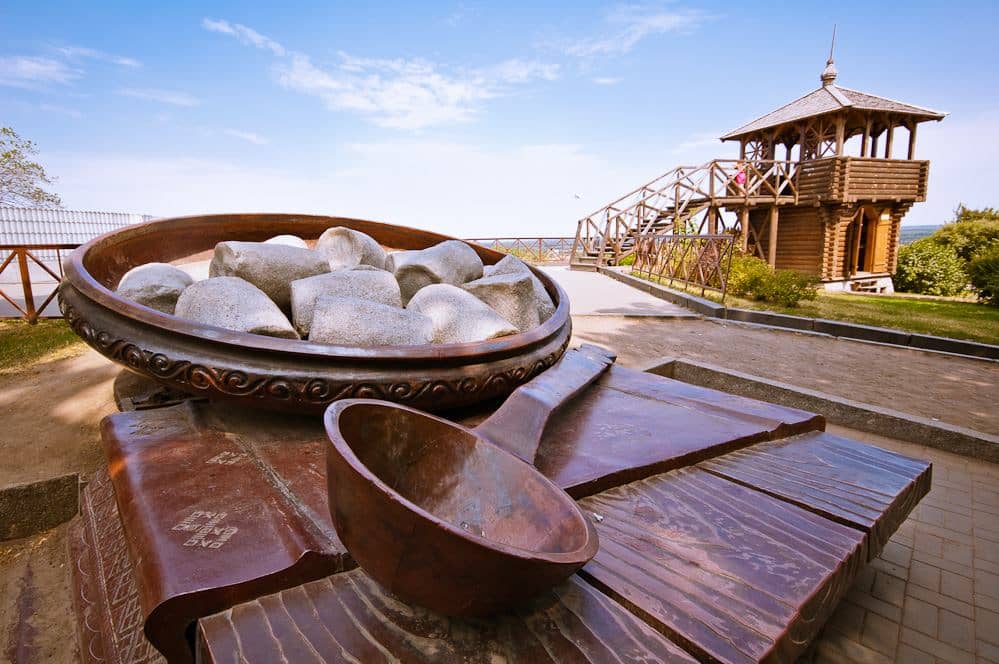
History of the origin of Halushky
It was an extremely common dish, as they can be made by everyone, even without special skills.They are often mentioned in works of art of the 18th-19th centuries. Ukrainian dumplings Halushky are described by Ivan Kotlyaresky in the Eneyida and Mykola Gogol in “Evenings on a Farm NearDykanka”.
The origin of the name “halushka” is associated with the word “halka” (“ball”, “piece of the soil”). Besides the Ukrainian, this word is found in other Slavic languages: Polish – gałka (“ball”), Czech – halka (“painful growth on plants”), Slovenian – galka (“ink nut”). Later, the name “halushka” became so widespread that the surnames “Halushka” and “Halushko” came from it.
Ingridients of dumplings Halušky
The traditional recipe of Halushky includes flour, eggs, and sometimes different mashed vegetables or cottage cheese. The most widespread everyday ethnic recipe is Halushky with pork rings made from suet (the hard white fat).
When is the Haluski traditionally eaten?
Usually boiled or steamed, you can eat Halushky immediately or freeze them for the future with further reheating or roasting.
Traditional way to serveHalusky
Ukrainian dumplings Halushky is an excellent main dish that can be served just with butter, sour cream or any gravy and sauce, some raw vegetables, cooked meat or fish.
Link to the step-by-step Halushky recipe with photos by the traditional Ukrainian cuisine Etnocook:
LOPATKY WITH PORK RINDS
What is the Ukrainian dish Lopatky?
The Ukrainian dish of tender fresh unripe pods of beansLopatky cooked in sour cream is very famous and popular, especially among Hutsuls – the native people of the Ukrainian Carpathian Mountains in Western Ukraine.
A Cultural History Of Lopatky
The young snap beans Ukrainian Hutsul people call “lopatky” and use these unripe vegetables to prepare a tasty and nutritional dish of the ethnic Ukrainian cuisine.
Snap beans “lopatky” consider being a late Ukrainian dish. To cook it are used ingredients originating in Central and Northern America and taken to Europe in the 16th-17th centuries. Snap beans were spread on the territory of Ukraine in 18-19 centuries and became as popular as the traditional local beans.
Ingredients for snap beans Lopatky
The traditional recipe offers to stew snap beans in sour cream with garlic and seasoning, and add pork rinds, cooked separately. For this Ukrainian recipe can be taken any green or wax beans (with a yellow or white pod), string beans, stringless beans, runner beans.
The taste of Lopatky
Flavorful, juicy immature pods of beans have a delicate flavor and almost no coarse fibers.
How the Ukrainian Lopatky is served
Lopatky can be also served as a side dish to other Ukrainian traditional foods, such as Varenyky or Halushky. It is a delicious seasonal dish full of a huge amount of the necessary nutrients and fiber.
Link to the step-by-step Lopatky recipe with photos by the traditional Ukrainian cuisine Etnocook:
SHPUNDRA
Exactly, what is Shpundra?
Shpundra (Shpundry, Spundra, Spundria) is a traditional Ukrainian dish -stewed boar meat in the beet root kvass
History of Shpundry from the medieval times
Shpundra was popular among Slavic warriors Cossacks in the 13th-17th centuries. Ukrainian Cossacks originated in the steppes (Wild Fields) in the territory of present-day Ukraine, north of the Black Sea and Azov Sea. They had their special unique Cossack dishes that were cooked besides the Ukrainian Borshch, Varenyky and Halushky, and Shpundra was one of them.
Ivan Kotlyarevskyi, describing the Cossacks in his adaptations in the burlesque poem Eneyida, wrote in 1798: “There was a borsch to shpundra with beets”
Shpundra Ingridients
The ethnic recipe of Shpundra was reconstructed by Etnocook and it is meat (usually pork) stewed with beetroots and Beet Kvass.
How did the Ukrainians traditionally served Spundra
Served hot with greens, tastes very good with green onions. Shpundra can be a main dish or goes with Halushky and stewed vegetables as side dishes.
Link to the step-by-step Shpundra recipe with photos by the traditional Ukrainian cuisine Etnocook:
ROAST DUCK WITH APPLES AND HONEY
What is the Ukrainian dish Roasted Duck?
There is a great possibility that the traditional recipe of roasted duck is one of the most ancient.
History of roasting poultry on the Ukrainian territories
The territories of modern Ukraine were very rich with animal and birds hunted for food. Wild waterfowl have been valued by people who lived on Ukrainian lands since prehistoric times. Archaeologists find here ducks on paintings from the last Ice Age (2.6 million years ago – 11,700 years ago). Ukrainian ancestors hunted ducks in traps for delicious nutrient food, warm and lightweight down, and feathers.
Traditional ingredients for the Roasted duck
The ethnic recipe of Duck roasted in apples with honey and herbs is reconstructed and adapted to modern conditions by the traditional ethnic cuisine Etnocook, however, you can cook it in the open fire as well. It will take some time but the result is gorgeous.
All you need is duck meat, apples, honey, garlic, onions, some salt, pepper and greens to taste.
When did the Ukrainians usually eat Roasted Duck
In contrast to densely populated Europe, where only wealthy people could hunt, game meat was a common dish in Ukraine. Serve it as a main course for lunch or dinner, with Varenyky or Halushky
Traditional way to serve Ukrainian Roasted Duck
Serve the delicious roasted poultry cooked with the traditional recipe hot, with herbs and just enjoy the moment through the delicious connection between the generations.
Link to the step-by-step Roasted Duck recipe with photos by the traditional Ukrainian cuisine Etnocook
PORK LOIN COOKED IN THE OVEN WITH HERBS
What is traditional Ukrainian Pork loin with herbs?
For the Pork loin roast is taken a part of the pig meat called loin, which is a cut from the tissue along the dorsal side of the ribs. In advance, before cooking, for tenderizing use a marinade made of beet root kvass, honey, vegetable oil, salt, pepper, basil, rosemary, onions, crushed garlic, ginger, bay leaf, greens to taste.
History of the roasted Pork Loin in Ukraine
Actually, not only the lands of modern Ukraine were rich, but also the Ukrainian ancestors were extremely smart and began to cultivate plants and domesticate animals very early.
It’s an interesting culinary fact, that pigs had been considered to be sacral animals since ancient times, and have were domesticated as early as 13,000–12,700 BP. They were broadly cultivated and grown for meat, leather, bristly hairs and bones. Since Kyiv Rus (KievanRus) times (IX-XIII) there have been written evidence about their importance and there are a lot of traditional recipes about how to cook pig meat (pork) back from there.
Ingredients for the Pork Loin in oven with herbs
For the Pork Loin you’ll need a piece of pig meat – a cut from the tissue along the dorsal side of the ribs. Additionally are used salt, pepper, garlic, onions, carrot, dill, parsley. Find the whole recipe with detailed instructions, tips and useful pieces of advice on the Entocook website.
Fully-cooked with the traditional recipe minimally processed tender pork loin is a great source of zink, iron and protein with the essential amino acids.
When to eat roasted Pork Loin
To tell you the truth, it wasn’t an everyday dish, more cooked for holidays, especially in winter time, because in late autumn pigs were killed and their meat was stored for special occasions.
How the Ukrainians traditionally served baked Pork Loin
Serve the Ukrainian traditional dish Pork loin roasted with herbs hot or cold. Cut it in individual chops with one bone in. Eat with gravy, sauces, tsvitly (beetroots with horseradish).
Link to the step-by-step Pork loin recipe with photos by the traditional Ukrainian cuisine Etnocook
TSVITLY (BEET SAUCE WITH HORSERADISH)
What is the Ukrainian dish Tsvitly?
Tsvitly also known as tsvikli (tsvykli) and tsvikly (tsvykly) or Red Chrain dish (chervonyi hrin, ukr.) is the traditional Ukrainian sauce (sometimes it’s called a salad) made of beetroots, horseradish root and Beet Kvass.
The Ancient History of Tsvykli
Tsvitly is known in traditional cuisine from Kyiv Rus times since the ninth century and is popular in our days as well. Beet and horseradish were widely used by Ukrainian ancestors as food and cure. Tsvitly is a sacral dish traditionally cooked for the most popular on the ancient spring holidays now known as Easter.
Tsvitly Ingredients
Tsvitly is a very simple and healthy dish. In traditional recipes it is made of baked beets, grind horseradish and the traditional beverage Beet Kvass.
How Tsvitly is served
Tsvykli is usually served with meat, fish or a salad, but in very little amounts because it tastes very spicy.
Link to the step-by-step Tsvitly recipe with photos by the traditional Ukrainian cuisine Etnocook
CHEESE PANCAKES WITHOUT FLOUR (SYRNYKY)
What is the Ukrainian dish Syrnyky?
These tasty and nutrient gluten free pancakes are very good for everyone. As it is well known, Ukrainians has used cottage cheese (fresh homemade curd) in ethnic dishes from ancient times.
The traditional recipe of the Cottage Cheese Pancakes (Syrnyky, Syrniki) is very easy and to cook them in the oven takes a minimum of time. This is a very healthy ethnic Ukrainian dish especially good for breakfast and as a healthy snack.
Ingridients for cheese Syrnyk pancakes
For this incredible good pancakes you’ll need cottage cheese, and a chicken egg. While forming future pancakes dried or fresh berries and fruits can be added, usually, these are cherries or raisins.
How the Ukrainian Syrnyky is served
Serve the traditional Ukrainian Cheese Pancakes Syrnyky hot, with sour cream or homemade jam. The best time is for breakfast in the morning, it will give you the energy and good mood for the whole day.
MAKIVNYK (UKRAINIAN POPPY SEED ROLL)
What is original Ukrainian dish Poppy Seed Roll Makivnyk?
The Ukrainian traditional Poppy Seed Roll Makivnyk will definitely surprise your friends, family and guests, however, it needs some skill to cook it.It’s for sure that the Ukrainian traditional Poppy Seed Roll Makivnyk is the true love from the first bite.
A Cultural History Of Makivnyk
It is very famous among ancient ethnic dishes in traditional cuisine because the Ukrainians were very good at making sourdough starter dough and the poppy seeds symbolized stars in the sky and plurality of worlds.
In August Ukrainian ancestors celebrated the harvest holiday called Makoviy. This was a special day when bouquets made of different herbs and poppy seed rolls were blessed. Among flowers in bouquets had to be large-ripe poppy heads.
When to eat poppy seeds roll Makivnyk
Poppy Seed Roll is a very popular pastry in Ukraine commonly baked on Winter and Spring Holidays (especially at Christmas and Easter).
How Makivnyk traditionally is served
Serve cold, in some time after baking, usually with a cup of milk or Uzvar (Ukrainian dried fruits and berries beverage).
The taste of Makivnyk
The traditional Ukrainian Makivnyk is so tasty itself that doesn’t need any additions to it.
Link to the step-by-step Ukrainian Makivnyk recipe with photos by the traditional Ukrainian cuisine Etnocook
OBLYZNI: BAKED SWEET COOKIES
The traditional Ukrainian Oblyzni are the little sweet baked cookies with the whole nuts filling.
What are traditional Oblyzni made of?
According to the ethnic recipe, you’ll need flour and whey (milk serum) or bread kvass, and nuts (usually chestnuts or forest nuts) as the filling. Although dried cherries, raisins can be used in the traditional recipe of oblyzni from Etnocook.
How originally Oblyzni taste
If you are of Ukrainian origin, the taste of Oblyzni will take you back to a cheerful childhood because these were very popular sweets cooked in Ukraine for centuries.
How Oblyzni are served
Traditionally these soft and crunchy little cookies are served with honey.
Link to the step-by-step Oblyzni recipe with photos by the traditional Ukrainian cuisine Etnocook
TRADITIONAL BREAD KVASS
When the temperature outside is very high, the freezing cold traditional Ukrainian fermented beverage Kvass is practically lifesaving.
A Millennial history of the Kvass
It has been known since ancient times and was very popular among Ukrainians in Kyiv Rus (Kievan Rus). The first written mention about Kvass was the year 996 C.E. in an ancient book the “Primary Chronicle” (“The Tale of Bygone Years”).:
“He [the king] ordered to equip carts and put [on them] loaves of bread, meat, fish, and various vegetables, and honey in barrels, and in the others kvass.”
Ingridients of the traditional Ukrainian Kvass
In the Ukrainian land Kvass was made with beets, fruits, flour, and bread. The ancient recipe for extremely healthy and refreshing Ukrainian beverage Bread kvass (rye-wheat bread and sourdough starter) from the culinary site of the traditional ethnic cuisine Etnocook is very simple. Just follow it and in a couple of days enjoy a non-alcoholic drink.
The right way to serve Kvass
The traditional Bread Kvass better tastes cold.It is often served with meat dishes. Traditionally, kvass was stored in barrels, from where it was strained into large mugs.
Link to the step-by-step Bread Kvass recipe with photos by the traditional Ukrainian cuisine Etnocook
MILLET PORRIDGE KULISH
What Exactly Ukrainian Kulish Is
The Ukrainian traditional Kulish (Kulesha) is a salty porridge made of millet. It was a very popular among Ukrainian warriors Cossacks and other military people because it’s very easy to cook in marching.
It was also widespread among peasants as a nutritional dish that can be cooked fast.
History of Kulish
Kulish has been known since Cossack times – 16-17 centuries. The dish was so popular that it gave rise to the common surname Kulish among Ukrainians. This surname had two famous Ukrainian writers -Panteleimon Kulish (1819-1897) and MykolaKulish (1892 – 1937). The surname Kulesha (Polish: Kulesza) was also given to the nobles of the Slepowron coat of arms, who lived in Ukraine in the 18th century and were recorded as Kulish and Kulesha.
When did the Ukrainians usually eat Kulish
Kulish is a universal dish, it could be eaten for breakfast, lunch and dinner. In peasant families, Kulish was often cooked in the morning, when there was not time and possibility to create difficult dishes.
HOLODETS (UKRAINIAN ASPIC)
Understanding what the Ukrainian Holodets is
Holodets (Kholodets) is a traditional gelatinous dish of the Ukrainian cuisine. It is made from meat broth, in the finished form the simmered thick broth turns into jelly.
Jelly contains collagen boiled from cartilage, which is good for ligaments and joints, as well as improves the condition of the skin, hair and nails, restoring their shine and strengthening them.
The cooking time is usually from 6 to 12 hours. The longer the jelly is cooked, the richer its taste and aroma will be, the better and stronger its consistency will be.
Where is Holodets originally from?
Kholodets has been known since ancient times by Eastern Slavs. It is a traditional dish of Ukrainian, Belarusian (халоднае, haladnae), Polish (studeneć), Slovak (Huspenina) and Slovenian (hladétina) cuisine. Jelly is one of the traditional ceremonial Christmas dishes. Traditionally, holodtsi are made in winter, because their preparation requires low temperatures, which in most Slavic countries were only in the winter months.
Ingridients of the holodets
In the traditional version, it is prepared without gelatin or other artificial additives. Meat with bones, water, horseradish, sometimes mustard seeds
When is the holodets traditionally eaten?
Holodets was a dish for the holiday table, usually for lunch or dinner.
Traditional way to serve kholodets
Kholodetsis served exclusively cold, usually on a large platter garnished with fresh herbs. Holodets is often served as a meat dish with the main course.
